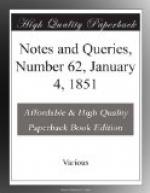He states that the oldest inhabitant of Hampstead, Mr. Rowbotham, a clock and watchmaker, died recently, at the age of ninety. He told his son and many other persons, that in his youth the Upper Terrace Avenue, on the south-west side of Hampstead Heath was known by the name of “The Judges’ Walk,” from the circumstance of prisoners having been tried there during the plague of London. He further stated, that he had received this information from his grandmother.
C.R. WELD
Somerset House.
Gray’s Alcaic Ode.—A question asked in Vol. i., p. 382, whether “Gray’s celebrated Latin Ode is actually to be found entered at the Grande Chartreuse?” is satisfactorily answered in the negative at p. 416. of the same volume, and its disappearance traced to the destructive influence of the first French Revolution.
It may not, however, be without interest to some of your readers to know, that this elegant “Alcaic” was to be found at the Chartreuse not very long before the outbreak of that great political tempest, proof of which will be found in the following extract taken from the 9th volume of Malte-Brun’s Annales des Voyages, Paris, 1809. It is found in a paper entitled “Voyage a la Grande Chartreuse en 1789. Par M. T*******,” and is in p. 230:
“L’Album, ou le grand livre dans lequel les etrangers inscrivent leurs noms, presente quelquefois une lecture interessante. Nous en copiames quelques pages. Le morceau le plus digne d’etre conserve est sans doute l’Ode latine suivante du celebre poete anglais Gray. Je ne crois pas qu’elle ait ete publiee encore.”
Then follows the ode, as usually printed, excepting that in the third line,
“Nativa nam certe fluentia,”
the words “nam certe” are transposed.
G.B.
Fleet Marriages.—The General Evening Post, June 27-29, 1745, contains the following singular Note of a Fleet Marriage:—
“Yesterday came on a cause at Doctors’ Commons, wherein the plaintiff brought his action against the defendant for pretending to be his wife. She in her justification pleaded a marriage at the Fleet the 6th of February, 1737, and produced a Fleet certificate, which was not allowed as evidence: she likewise offered to produce the minister she pretended married them, but he being excommunicate for clandestine marriages, could not be received as a witness. The court thereupon pronounced against the marriage, and condemned her in 28l., the costs of the suit.”
Y.S.
* * * * *
QUERIES.
HISTORIE DES SEVARAMBES.
The authorship of Gaudentio di Lucca has recently been discussed by some of your correspondents, and it has been shown that this Voyage Imaginaire {5} was written by Simon Berington, a Catholic priest, and the member of a family resident for many years in Herefordshire. The following Query will relate to another work of the same class, but of an earlier date.




